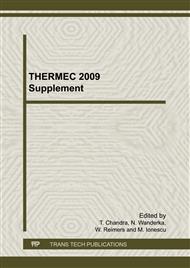p.721
p.727
p.733
p.739
p.745
p.751
p.757
p.763
p.769
TEM Study and Magnetic Measurements of Nano–Scale Particles Formed in Cu–Base Alloys
Abstract:
The precipitation behavior of nano–scale particles formed in Cu–base alloys was studied by means of transmission electron microscopy (TEM) and SQUID measurements. Linear arrangements of two or more nano–scale particles cubic in shape were observed in the <100> orientations of matrices in a Cu–Co alloy. Although the trend was less explicit in a Cu–Fe alloy, Fe precipitates accompanying twin–like lattice modulations were found in the decomposition, when no deformation was applied. The present SQUID measurements revealed several significant influences to magnetic properties were induced during the precipitation in Cu–base alloys. Lorentz electron microscopy confirmed that phase transformation from γ → α occurred at the stage that the Fe particles reach to 40~60nm in size.
Info:
Periodical:
Pages:
757-762
Citation:
Online since:
January 2010
Authors:
Keywords:
Price:
Сopyright:
© 2010 Trans Tech Publications Ltd. All Rights Reserved
Share:
Citation:


